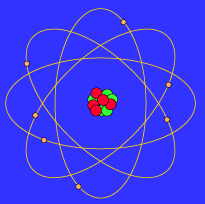Redox Reactions Involving Nonmetals Only
The situation is a bit more complex when nonmetals atoms are involved. As all nonmetals have similarly high electronegativity values, it is unreasonable to assume that there will be a transfer of electrons between them in an oxidation-reduction reaction. In these instances the valence electrons involved can no longer be thought of as being "lost or gained" between the atoms, but instead, are only partially transferred, moving closer to that atom which has the higher electronegativity (and away from the atom of lower electronegativity). This "shift" of electrons results in an unequal distribution of charge, as the more electronegative atom becomes more "negative" and the atom of lower electronegativity becomes more "positive".
The accurate determination of the distribution of charge resulting from these "electron shifts" is very difficult, but guidelines have been devised to simplify the process. In general, these guidelines assign the more electronegative atom a negative oxidation state, and the atom with the lower electronegativity, a positive oxidation state. One should be aware that these guidelines are at best, arbitrary approximations, and in some instances may have to be supplemented by additional methods.
skip to main |
skip to sidebar


Bhor's atom model
Oxidation reduction reaction.
Search

Custom Search
How is this blog?
Blog Archive
-
▼
2009
(24)
-
▼
August
(24)
- Oxidation Reduction
- Oxidation states
- Definition of oxidation reduction
- Ionic compound
- Ionic formulas
- Electronegativity
- Electronegativity & Metal/Nonmetal CompoundsAs ind...
- Redox Reactions Involving Nonmetals OnlyThe situat...
- Guidelines - Oxidation States of Nonmetals1. When ...
- Types of redox reaction.
- Combination reactions
- Decomposition reactions
- Single displacement reactions
- Balancing Redox Reactions Using the Half Reaction ...
- Balancing Redox Reactions in Basic Solutions
- Bleaching Agents (Application of redox reaction)
- Photosynthesis (Application of redox reaction)
- Metabolism (Application of redox reaction)
- Nitrogen Fixation(Application of redox reaction)
- Combustion of Fuels (Application of redox reaction)
- The "Dry-Cell" Battery
- Electrochemical Cells (Application of redox reaction)
- Photo-oxidation - Photochromic Glass (Application ...
- Corrosion (Application of redox reaction)
-
▼
August
(24)
Labels
- . single displacement reactions (1)
- balancing redox reactions in basic solutions (1)
- balancing redox reactions using the half reaction method (1)
- bleaching agents (1)
- combination reaction (1)
- combustion of fuels (1)
- corrosion (1)
- decomposition reactions (1)
- definition of oxidation reduction (1)
- electrochemical cells (1)
- electronegativity (2)
- ionic compound (1)
- ionic formula (1)
- metabolism (1)
- nitrogen fixation (1)
- oxidation number (2)
- oxidation reduction (1)
- Photo-oxidation - Photochromic Glass (1)
- photosynthesis (1)
- redox reactions (1)
- the "Dry-Cell" battery (1)
- Types of redox reaction (1)
Image

Bhor's atom model

No comments:
Post a Comment